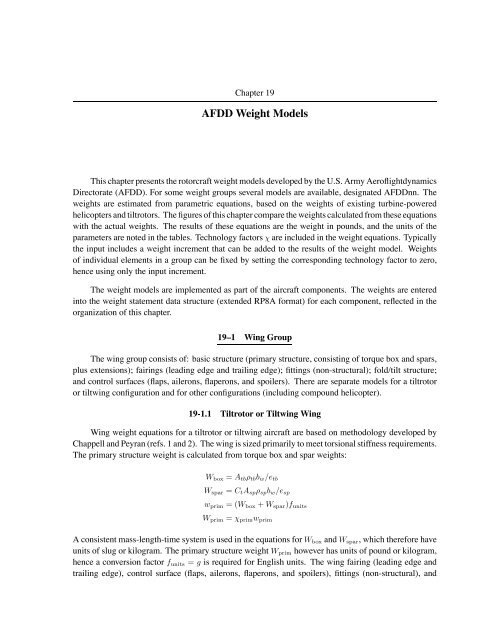Download - NASA
Download - NASA
Download - NASA
You also want an ePaper? Increase the reach of your titles
YUMPU automatically turns print PDFs into web optimized ePapers that Google loves.
Chapter 19<br />
AFDD Weight Models<br />
This chapter presents the rotorcraft weight models developed by the U.S. Army Aeroflightdynamics<br />
Directorate (AFDD). For some weight groups several models are available, designated AFDDnn. The<br />
weights are estimated from parametric equations, based on the weights of existing turbine-powered<br />
helicopters and tiltrotors. The figures of this chapter compare the weights calculated from these equations<br />
with the actual weights. The results of these equations are the weight in pounds, and the units of the<br />
parameters are noted in the tables. Technology factors χ are included in the weight equations. Typically<br />
the input includes a weight increment that can be added to the results of the weight model. Weights<br />
of individual elements in a group can be fixed by setting the corresponding technology factor to zero,<br />
hence using only the input increment.<br />
The weight models are implemented as part of the aircraft components. The weights are entered<br />
into the weight statement data structure (extended RP8A format) for each component, reflected in the<br />
organization of this chapter.<br />
19–1 Wing Group<br />
The wing group consists of: basic structure (primary structure, consisting of torque box and spars,<br />
plus extensions); fairings (leading edge and trailing edge); fittings (non-structural); fold/tilt structure;<br />
and control surfaces (flaps, ailerons, flaperons, and spoilers). There are separate models for a tiltrotor<br />
or tiltwing configuration and for other configurations (including compound helicopter).<br />
19-1.1 Tiltrotor or Tiltwing Wing<br />
Wing weight equations for a tiltrotor or tiltwing aircraft are based on methodology developed by<br />
Chappell and Peyran (refs. 1 and 2). The wing is sized primarily to meet torsional stiffness requirements.<br />
The primary structure weight is calculated from torque box and spar weights:<br />
Wbox = Atbρtbbw/etb<br />
Wspar = CtAspρspbw/esp<br />
wprim =(Wbox + Wspar)funits<br />
Wprim = χprimwprim<br />
A consistent mass-length-time system is used in the equations for Wbox and Wspar, which therefore have<br />
units of slug or kilogram. The primary structure weight Wprim however has units of pound or kilogram,<br />
hence a conversion factor funits = g is required for English units. The wing fairing (leading edge and<br />
trailing edge), control surface (flaps, ailerons, flaperons, and spoilers), fittings (non-structural), and
















